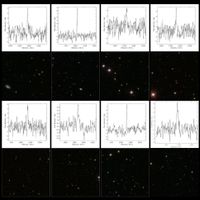Eight Clouds In Virgo That Don't Do Anything
These rather innocuous-looking things have been the backbone of my research since I first started. My PhD was based around the two AGES maps of parts of the Virgo Cluster, where we'd hoped we'd find more features similar to VIRGOHI21.
At first, we didn't. In the first survey field, long steams like that one were nowhere to be found. In fact it was a bit pathetic, with a grand total of 13 HI detections, all of which were previously known and all had clear optical counterparts ! Fortunately the second, larger field, turned out to be chock-full of interesting stuff. Chief among these were the clouds.
They're not much to look at. In our data they're unresolved, so we can only put an upper limit on how large they are. We can, however, accurately measure the speed of the motions within the clouds... and that's weird. Different parts of each cloud are moving as much as 180 km/s differently to other parts, and that's very much higher than what we expect for typical "debris" produced in galaxy interactions.
We can also measure their total HI mass, and perhaps most importantly we can investigate their context. That is, we know that these are pretty isolated considering that they're in a dense cluster, and none of the galaxies nearest to them show signs of any extensions. We also know their rate of occurrence, eight in 20 square degrees (about 10%) of the Virgo Cluster – uncommon, but certainly not at all exceptional. But without being able to properly resolve them, we can't say for sure what they are.
Three main interpretations have been proposed for their unusually fast motions :
- Their motions are due to rotation. In this case, they'd almost certainly need a large dark matter halo to bind them together, otherwise they'd fly apart so quickly that they should be much closer to their parent galaxies. If they were small enough to be self-bound by their HI mass alone, they'd be so dense that we'd expect them to be forming stars at an ungodly rate, which they aren't. So in essence, rotation ≡ dark galaxies.
- We're seeing streaming motions along the line of sight. That is, these are just ordinary bits of tidal debris produced in galaxy-galaxy encounters, or possibly due to ram pressure stripping. This explanation really doesn't work : again, if they were unstable, they'd be highly unstable, so much so that we wouldn't expect to ever detect them, as they'd quickly expand and reach density levels far too low to detect.
- They have randomised bulk internal motions but held together by the intracluster medium. This idea is that the we're not seeing large-scale streaming motions of the clouds, but something more randomised. In principle, this means the gas present within the galaxy cluster could act to help prevent the clouds from dispersing. However our simulations showed that this doesn't work either, with such clouds still exploding rapidly.
On the face of it (1) – somewhat surprisingly – is by far the easiest and simplest explanation. Tantalisingly, we also know that very faint, "low surface brightness" galaxies also exist... so why not truly no surface brightness galaxies as well ? And our simulations also showed that dark galaxies matching the parameters of these objects could be extremely stable, allowing them to be detectable for much longer than any other explanation.
Now this is not to say that we mean all clouds are more likely to be dark galaxies than debris – not at all ! But we established quite strict constraints on when the tidal debris hypothesis becomes less likely. In our simulations isolated clouds of line widths < 50 km/s are common, but those of 50-100 km/s are rare, and above 10 km/s they're virtually absent. It's this combination of isolation and line width which is important. High line width features are common in extended streams, but not at all in isolated, discrete clouds.
Very recently we started analysing the VLA data of these objects. This is nowhere near as sensitive but it has significantly higher resolution. And now it looks like the true explanation might be something that's a mixture of (1) and (2). With the higher resolution, we can pinpoint the location of each clouds far more precisely, and it seems that some of them at least do have optical counterparts – incredibly faint, so much so that you'd never spot them otherwise. So they are galaxies after all, if just very faint rather than dark. But the structure of the objects is not much like a regular galaxy. What we think we're seeing – and much work needs to be done on this – is dwarf galaxies caught in the first moments of ram pressure stripping. Whether that could explain the highly unusual kinematics of these objects remains to be seen.
You can read about the observational weirdness of these objects here, the simulations of (1) and (2) here and here, and the simulations for (3) here.
